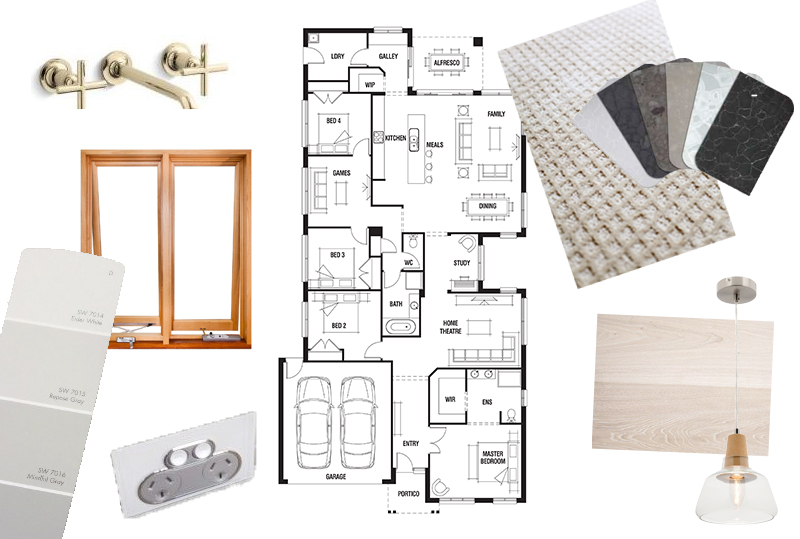One of the advantages of building a new home is that you get to start from scratch with the floor plan. The new house plan is your opportunity to create the perfect for your family and lifestyle.
The process of choosing a new house plan is one of the most important decisions you will need to make when building a new home, and there are lots of things you need to consider. Does it suit your lifestyle? Is the layout practical? How livable is the layout for your family? These are just some of the questions you need to ask yourself before you select and then signing off your plans.
Combining advice from industry experts, and tips from homebuyers that have been through this before, this is the ultimate house plans checklist to ensure you get it right first time.
Choosing a floor plan
- Don’t assume every floor plan will fit your family and lifestyle. Builders put a lot of planning and thought into all of their floor plans, but this doesn’t necessarily mean it will be perfect for your specific needs.
- Check the room sizes on the floor plan are adequate for you. Consider furniture layout and use. Just as you might find a bedroom is too small for the double bed you need to put it in, so too, sometimes rooms can be larger than you actually need.
- When viewing display homes, in your mind, try to strip away all the upgrades, and visualize the floor plan without getting distracted by the beautiful benchtops, sleek taps and gleaming bathrooms
- Ask whether the builder will allow changes to the floor plan to suit your requirements, and if so, to what degree. Find out exactly what is adaptable, and what is set (like structural changes).
- Measure a space from the floor plan in real life. This can help you feel the proportions of the space compared to your furniture etc. It’s handy to measure it in reference to your actual current spaces so that you have a reference point. Eg. Stand in your current bedroom and measure your new bedroom. Is it smaller or larger than what you currently have? From this point you can imagine how you will fill the space in the new floor plan.
- Builders design a floor plan in a certain way for good reasons – energy efficiency, orientation, privacy, best use of space, usability etc…So if you want a change it, discuss with the builder to understand the pros & cons of any changes you want to make.
Reading the new house plan
- If you don’t understand the plan, always ask (it is not assumed you should know how to read plans!).
- Ask for an elevation view plan from all aspects (as well as the floor plan view).
- Get familiar with some of the common symbols used (doors, windows, brick walls, plasterboard walls etc…)
- Measurements are most commonly shown as (length x width)
- Ask the builder about what’s not shown on the plan!
YOUR CHECKLIST – Before you sign off on your plans & specifications
General
- Ceiling heights: Check what ceiling height is included in the base house price (usually 2400mm). Consider increasing your ceiling height to at least 2700mm, you will be surprised at the instant feeling of space.
- Cornices: There are different types of profiles available, but also consider ‘square set’ which is where there is no cornice? This is more clean and modern looking, but will often cost additional.
- Internal doors: By increasing the height of your internal doors you can dramatically change the feeling of space. It is a visual trick that makes you feel like the ceilings are higher than they actually are.
- Windows: Check the window type on the plan (awning, sliding, casement, double hung). There are pros and cons to each window type – for example, awning windows protect from the rain, but they offer less ventilation. Windows should be placed to take advantage of prevailing winds and to maximise cross ventilation with another window or doorway. Are they single or double glazed? Do they have weather seals to increase thermal efficiency?
- Insulation: What is standard? Depending on where in Australia you live you may want to increase insulation within the house?
- Paint: How many paint colours are included, often it is only one? How much is it to have multiple colours?
- Storage: Is there enough? Consider using spaces such as under stairs, underfloor, under bench seats for example. Can you take a bit of floor space from the entryway for more storage? Could clever pull-out shelving increase utilization of space in the kitchen?
Kitchen
- Joinery: What shelves are included? Is a bank of draws included? Pot draws? Overhead kitchen cupboards? Built in space for a microwave? Do you want soft-close drawers? Will the fridge space fit your fridge?
- Layout: Do you have adequate space to prepare food? Where would your chopping board go? Where would your appliances sit? Can you carry hot pots to the sink easily? Have you considered the kitchen work triangle? Imagine entertaining and having a few people over. Can you prepare food and speak to guests easily?
- Plumbing: Do you need a water tap in the fridge space (if you are having a fridge with water/ice dispenser)? Consider a pull-down tap (especially if you have a small sink, it provides better flexibility).
Bathrooms / Wet Areas
- Tiles: Are wall tiles in the bathroom included? If so, to what height? Often they will only quote for half height. What pattern are the tiles laid?
- Bath/Shower layout: When designing your bath/shower layout, consider: how do you get in and out of the bath? Can you turn on the taps without getting wet? Are the taps in a safe position for children? Can you lean up against both ends of the bath without taps in the way? Is the shower head/rail high enough?
- Accessories: Check placements of toilet roll holders and towel rails to make sure they are accessible and don’t get in the way
- Toilets: Is there a toilet easily accessible from living areas? Does it offer noise privacy?
Bedrooms
- Robes: How many shelves and rails are included? Sliding mirror doors can be more expensive than wooden opening doors, however, if you have a small space they will be more practical.
- Bedrooms: Check the sizes of the rooms. Is it large enough to fit the size of bed you require? Some small bedrooms are not configured for more than a single bed. Plan where the windows are situated to suit your furniture layout.
- Bedroom placement within the house: Depending on what stage of life you are in, you might want to consider alternate placements. If you have a baby (or are likely to have one in the near future), you might want a small bedroom near the master (rather than at the opposite end of the house). If you have toddlers, is it easier having their bedrooms downstairs?
Electrical (watch for budget blow-out!)
Get an electrical plan done at the quoting stage. You will always need some level of customization, and it is a common area for a budget blow out, so plan for this early on in the process.
- Power points: How many power points are included? Often you will need to add in additional points, so factor this in. Don’t forget powerpoints in hallways (for vacuuming), near the bathroom vanity, beside the couch for lamps, beside the bed for lamps, outside alfresco areas, multiple locations in the kitchen (including on an island bench), charging stations for laptops/phones and in the garage.
- Lighting: How many lights are included in each room? What type of lights are included? Do you need dimmers (for living spaces is common) or two-way switches (for long hallways for example)? Imagine yourself in each room – where would you turn on and off your light switches? Can you see into your robes/cupboards? Imagine laying in bed, standing in front of the mirror etc… Think about the use – practical light (brighter), ambient light (not direct), task light (direct). Consider the orientation of windows in each room to understand how naturally light or dark they will be.
- Data points: Are data points and TV antennas in the right place?
- Heating & cooling: Is anything included? It is easier to heat/cool smaller spaces, so consider hallway doors to section off parts of the house for heating/cooling purposes.
Flooring
- Flooring: Most homes don’t include flooring as the standard. Get this priced up early in the process.
- Consider stairs if you have small children. Can you put a gate across them if you need to?
Outdoor (watch for budget blow out)
- Outdoor: Are garden taps included? What degree of landscaping, retaining walls, fencing, decking or ground cover is included or what is the additional cost?
- Driveways: Is it included? If so, what style of driveway is it? Is there a path to your front door?
- Garage: What kind of door is included? Is insulation included in the garage (if you are using this as a workshop, it might be handy). What are you going to use your garage for? Do you really need a double garage, or could you move the garage forward and put a storage room behind instead?
- Alfresco: Does outdoor living seamlessly connect with indoor living?
- Storage: Where do you store things like bikes, lawn movers?
Choosing the floor plan is an important decision, however, don’t do this in isolation of other decisions such as the location and orientation of your house on the block. A floor plan could look good on paper, but did you consider the outlook from your windows for example. The perfect floor configuration might not be as desirable if the outlook isn’t what you’re expecting. Make sure the plan fits with your block. If your’re still unsure, we share tips on how to boost feng shui.

- We’ll ask the right questions to better understand your needs
- We’ll create a recommended shortlist ideally matched to you
- We’ll answer specific questions or concerns related to home building, land purchasing or financing












